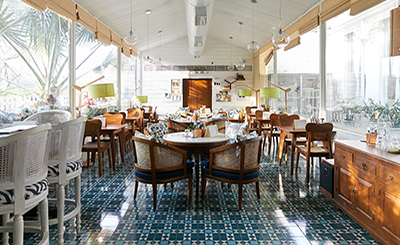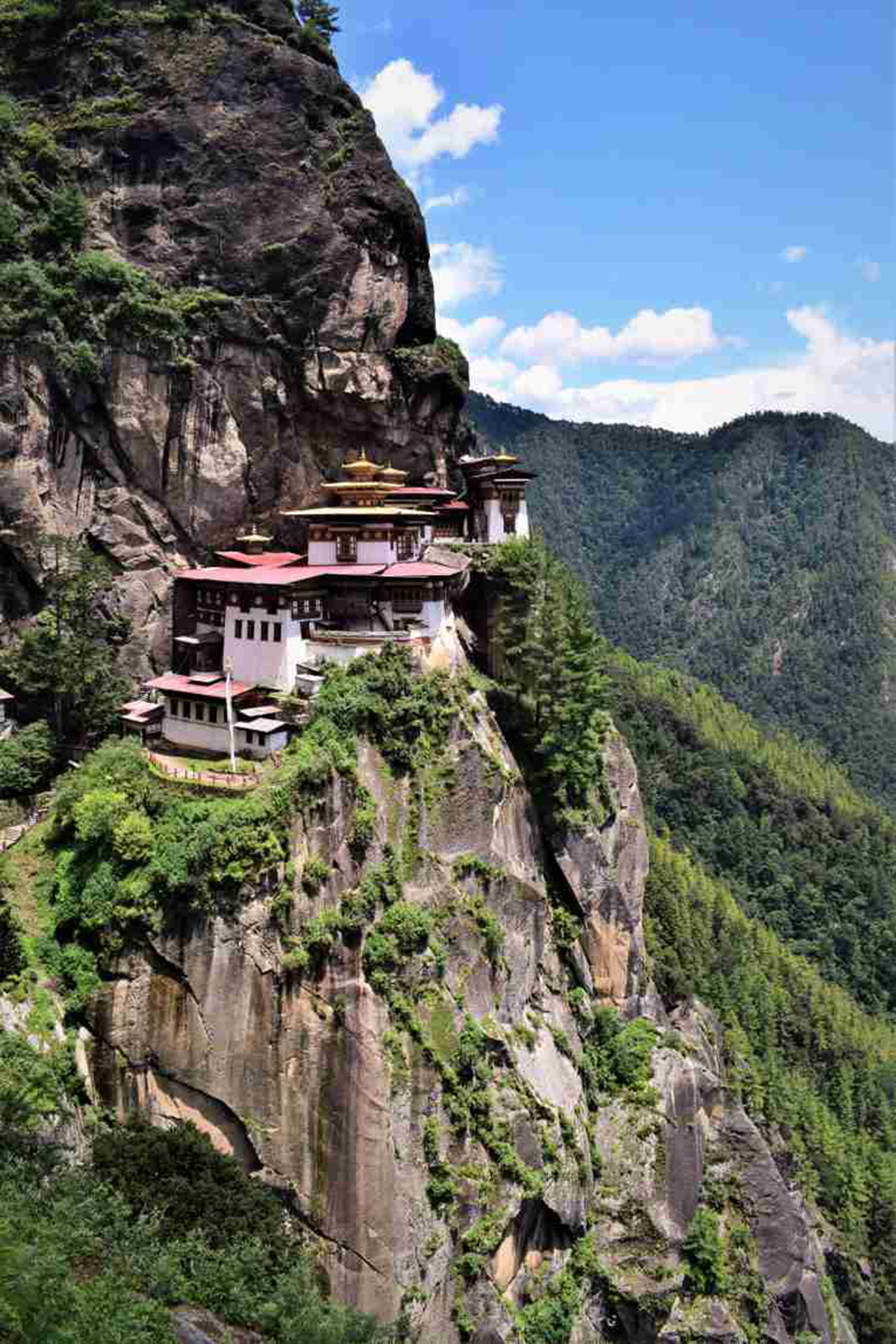
Tiger’s Nest perched precariously on the cliff. Photos: Girish Duraisamy
Taktsang, or Tiger’s Nest, a well-known landmark in Bhutan nestled against the dark grey cliff, patiently takes in seekers — young and old. It is a sea of silent prayers and contentment
Walking down a street in Thimphu, I approach a man to ask for directions to the Royal Palace. As he guides me to the road that I need to take, we fall into conversation and he asks me what I have seen so far. I reel off some names, but he isn’t very impressed. “Have you been to Tiger’s Nest?”
Taktsang, or Tiger’s Nest, is arguably the most well-known landmark in Bhutan. Search the internet for Bhutan, and a photograph of Tiger’s Nest, situated at the edge of a high cliff, pops up. Leaf through piles of postcards and magnets at the Weekend Market, and you will see its image everywhere. “Will you be able to do it?” is the question we face most often during our week in Thimphu, when we mention our ambitious plans to go up to the temple. We respond with jaunty confidence, but not without a flutter in the stomach.
Guru Rimpoche or Padmasambhava, known for introducing Buddhism to the kingdom, is believed to have flown on the back of a tigress to Taktsang and meditated there. The temple was built in the 17th century and is accessed from the town of Paro, about an hour and a half from the capital, Thimphu. The shrine is considered extremely sacred — a woman tells me that believers are expected to pay their respects there at least three times in their lifetime.
Bhutan, a kingdom high up in the Himalayas, wrapped in mystery and clouds, often arouses a great deal of curiosity. Deeply rooted in tradition and religion, it holds its Buddhist values close and shuns overt commercialism, the Gross National Happiness policy standing out as testimony to the ideals it has set itself. Though the country is ensconced between India and China, the mountains make it seem suspended at the edge of the world — Taktsang, even more so.
Bhutan is a land where legends co-exist with the present. Dragon motifs decorate windows and eaves; prayer wheels are continuously in motion, delivering prayers across generations. Reality strikes in the form of difficult mountain terrains, floods, and meagre livelihoods — but life flows gently, fluidly.
***
Sunday, the day of our trek, dawns bright and fair. A drizzle at breakfast worries us — what if Paro has already seen rain and the paths to the temple are slippery, considering that the week was so wet? Will we be able to make it to one of the viewpoints, let alone to the top? Besieged by doubt, partly by the amount of scepticism our enthusiasm generates, the six of us pile into the car that will take us to “base camp”. The driver, S., approaches the bends with practised gusto, smiling at the exhortations of the quirky signs planted along the way. “If you’re married, divorce speed,” says one. “Peep peep, don’t sleep,” reads another. He drives in an assured manner. We punctuate the silence with nervous laughter, anxiety and excitement mixing in unhealthy proportions.
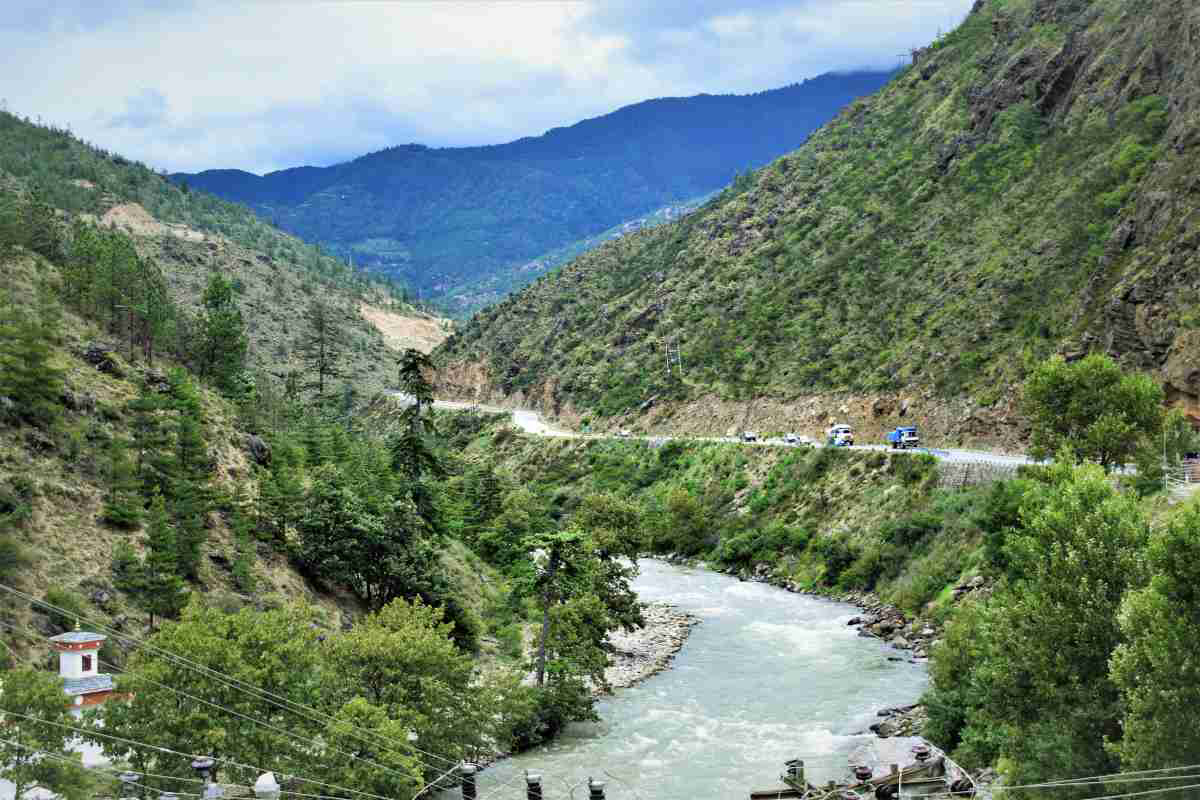
The picturesque drive from Bhutan to Paro
The road winds through lush valleys, with a river accompanying us most of the way. The mountain slopes go from forested to rugged to velvety, as the clouds disperse, allowing the sun to display the landscape to its full advantage. This is a good sign. When in Paro, we look out eagerly for the first glimpse of the temple, pretending, or trying to believe, that every building on the face of a rock wall is Taktsang.
The temple appears at last, a tiny speck nestled against the dark grey cliff face. It didn’t look this small in the pictures! My heart sinks to my shoes — I have read that this climb can be managed, slowly and steadily, by people who are not particularly fit. My exercise being limited to twenty minutes’ walking every evening, I am surprised that I even dared to come this far. I hope that it won’t be a case of fools rushing in where they oughtn’t to.
A closed passage leads from the parking lot to the point where we are to begin our climb. Women sit on platforms, selling trinkets studded with turquoise, malachite, and other semi-precious stones. Their attractions hold no charm even for the inveterate shoppers in our group today, who barely cast a glance at the beguiling wares. All that matters is the climb and, in our narcissistic world, photographs.
Mountains inspire, soothe, and calm. They possess power and character. You don’t know what the bend in the road will bring. In their magnitude and resilience, in their power to protect and to terrify, mountains are magnificent creations of nature.
Aided by sticks that serve as hiking poles, we begin the trek. A pack of mules and ponies lingers by the base, perhaps resting after conveying human cargo up to the viewpoint, beyond which all pilgrims have to take several flights of steps to get to the temple. We scramble over a few rocks and emerge in a clearing, before the path begins to get narrow and steep. I pause to look at the trees soaring upwards as if in silent prayer, the quietly grazing animals, and the forested Himalayas beyond. Our target is in sight, far up the cliff. This is a scene out of a beautiful dream, for I have always considered the Himalayas my spiritual home, even though I come from the sweltering coastal plains over fifteen hundred miles away.
A short distance ahead, we come across a creek that rushes into a tank, carrying sweet, refreshing water from the mountains. It powers a prayer wheel that turns slowly, diffusing energy into the surroundings. We splash ourselves, already relieved to have a break. Meanwhile, the oldest member of our group, who also happens to be the fittest, has sped ahead.
My preparation for the trek consisted solely of reading blog posts and taking walks around Thimphu, with one eye on the gorgeous mountains hemming the city. Some said that the trek could be easily accomplished; others indicated that certain sections of the path were difficult. I will confess that I find most of the stretches quite steep. Every time I turn a corner, I am astonished by the height we have achieved. The vast expanse of flat countryside grows distant and the houses turn small, like toy blocks scattered on a green carpet. On some occasions, the temple appears on the right, progressively separating into its individual units of white, maroon, and gold.
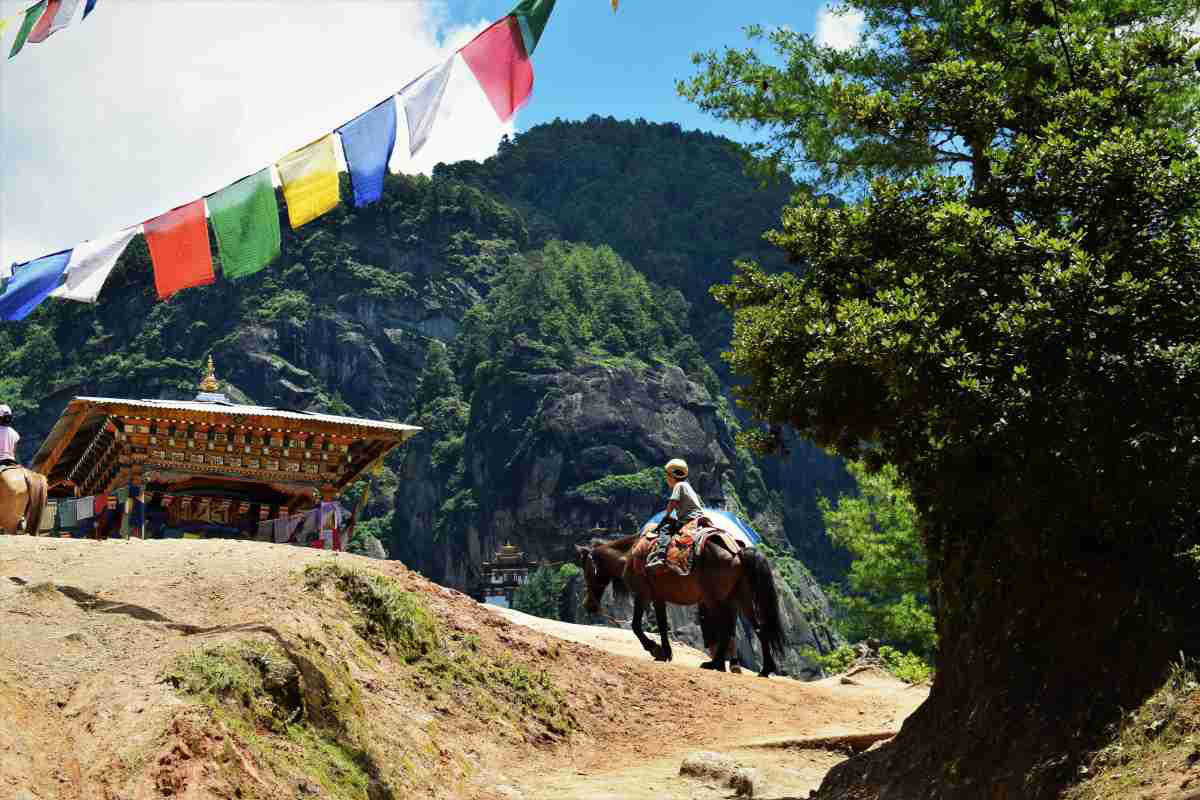
Stumbling upon a clearing
The walk reminds me of some of my favourite books. Jack Kerouac spent days up in a lonely mountain cottage in The Dharma Bums. Christopher McCandless walked bravely into the wilderness of Alaska in Into the Wild. Ruskin Bond takes regular serene walks in the Himalayas, enjoying the mountain streams and conversations with tea-stall owners, appreciating the act of walking without purpose. Mountains inspire, soothe, and calm. They possess power and character. You don’t know what the bend in the road will bring. In their magnitude and resilience, in their power to protect and to terrify, mountains are among the most magnificent creations of nature.
Chortens (Buddhist shrines) and prayer flags line the path. Some pilgrims pause to offer worship at shrines against the cliff. Most of the climbers are locals, but we also encounter a few foreigners on foot. A sort of amity develops among us outsiders, almost as if we are willing one another up or down the mountain, brought together by self-doubt or a sense of achievement. “I did it, so can you. You go, girl!” calls out a woman as she passes me on her descent.
Conversation is minimal, because most people are conserving their energy or chanting. Golden langurs appear amidst the branches of the conifers set on the slopes, their playfulness in contrast to the almost meditative atmosphere. We are now more or less at eye level with Taktsang; perhaps slightly above it. We hear the waterfall roaring just ahead, but to take the bridge across it, we have to go down several steps, and then climb back up to the temple.
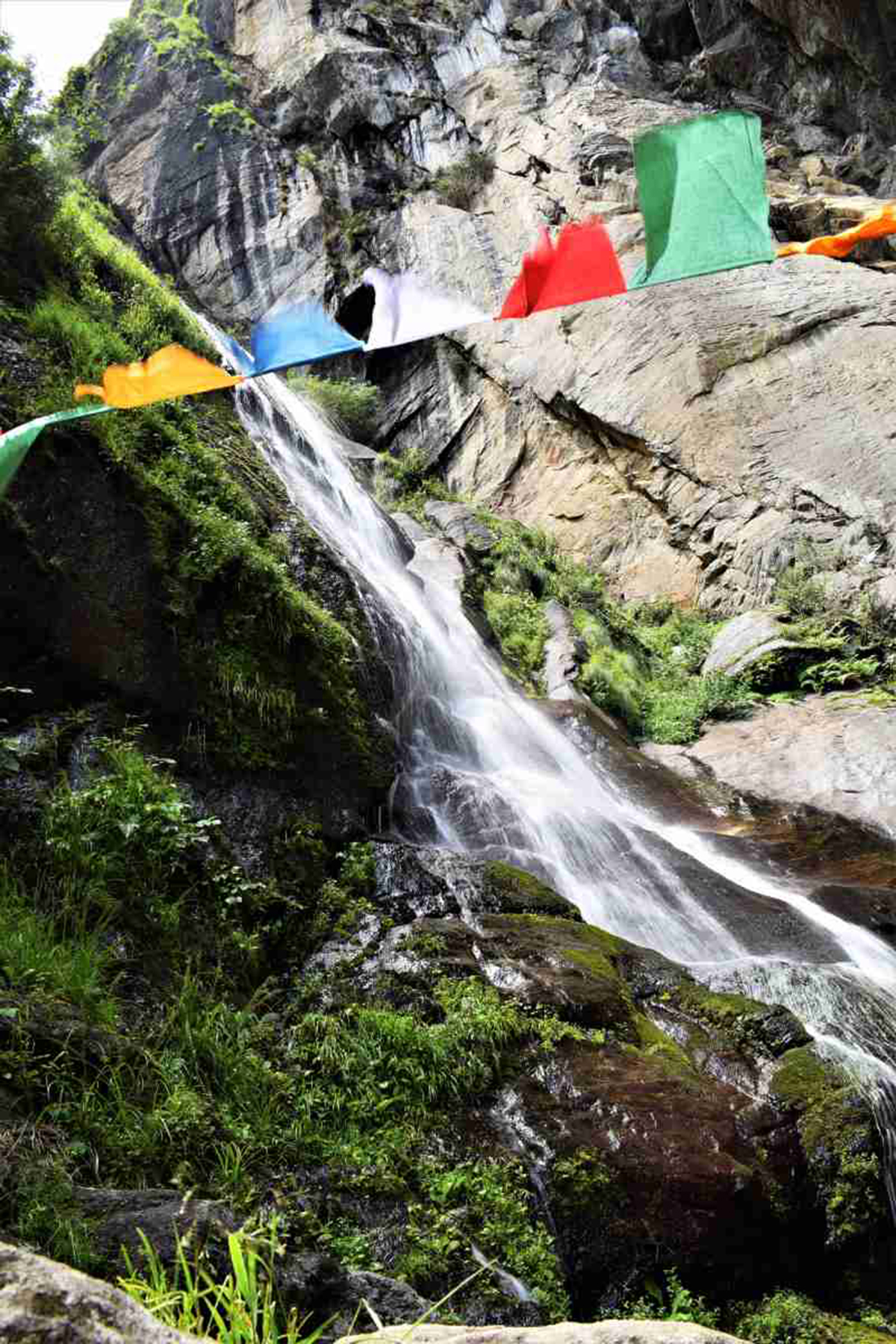
Approaching the waterfall, we shout to make ourselves be heard over its roar
Down the steps, across the bridge, up a final flight of stairs — and we are finally rewarded for our labour, arriving at Taktsang. A wave of happiness washes over me. Here, at over 10,000 feet in the Bhutan Himalayas, I am finally at a place that I have read about and seen pictures of. This is a dream come true, and to be here at last fills my heart to bursting point.
More steps await us as we are taken to the sanctum sanctorum, where a priest breaks off his meditation to offer us holy water. We are then ushered into a chamber some monks are filing into after their break. They sit on the floor in front of an older monk, who has a raised seat by a window. His sonorous voice fills the chamber as he raises a chant in what sounds like the throat-singing style, perhaps a throwback to Tibetan traditions. The other monks echo certain syllables, following up with a chant of their own. I listen entranced. Nepal, India, Tibet, Bhutan: an ancient religion has traversed a journey over two thousand years. The form in which it is being practised here is new to me, not to mention the mystique of the mountains adding to its depth. I understand neither the verses nor the significance of the ritual offerings. What I do feel is the presence of an enveloping, positive energy.
Further up is a narrow path into a cave, the actual Tiger’s Nest. A winding, steep flight of steps leads into it. Pressed for time, we take only a peep at it and turn around for the return to the base. We have no pictures of the temple as cameras are not allowed inside, but that is perhaps a blessing. We absorb everything with our own senses, storing memories for posterity.
Our group having split on the way to the temple, my husband and I make the trek back down on our own. The sun is suddenly blanketed by dark clouds. A shower descends on us even as we negotiate the steps, and sweeps across the countryside. For the next hour and a half, we are left almost on our own. As it is past two in the afternoon, no more people are coming up the hill.
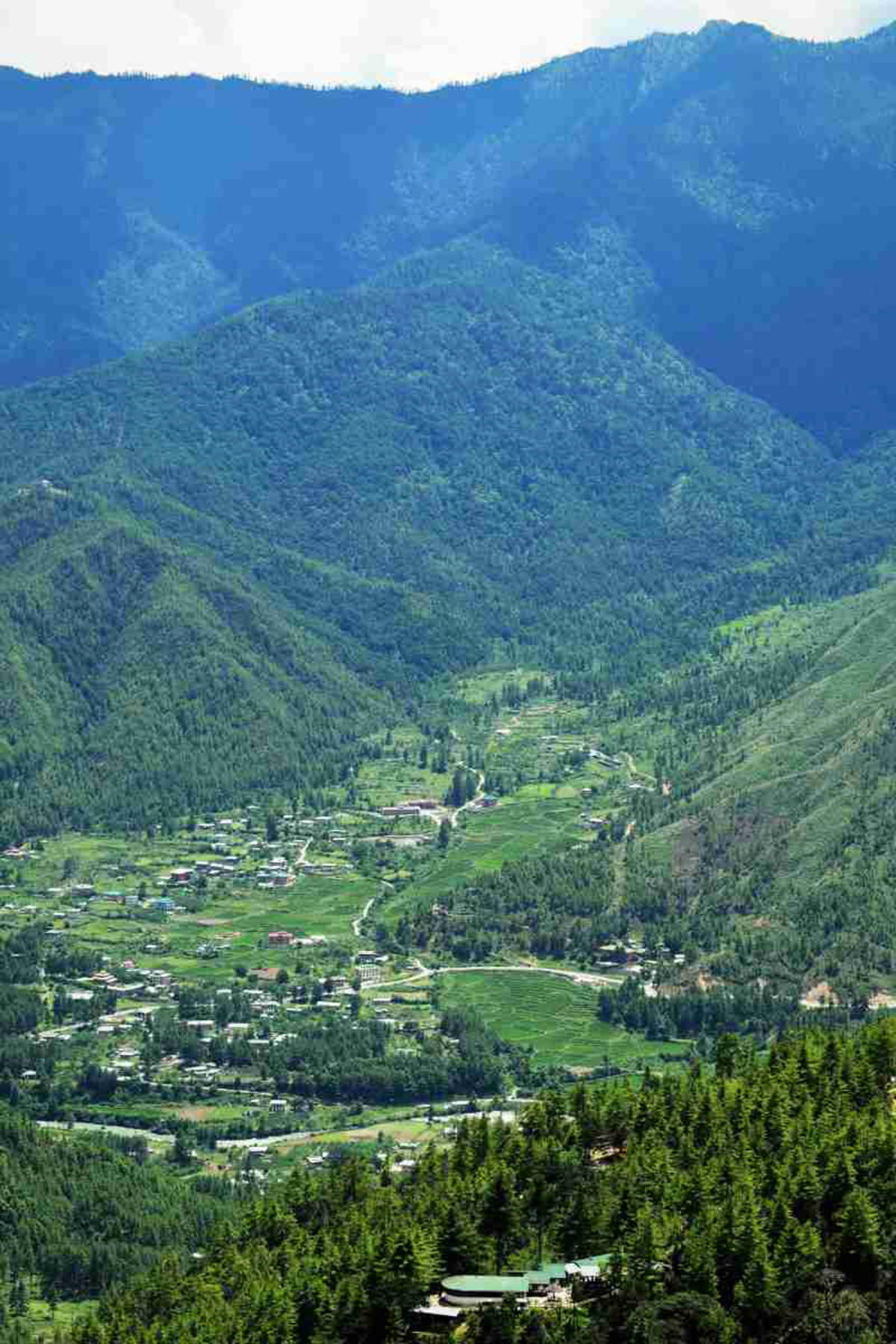
Clouds prepare to chase the sunshine away
The shower settles into a steady drizzle. An occasional gust of wind pushes against us, bringing along a burst of rain. Prayer flags whip vigorously in the wind, their arrhythmic flapping accompanying us down the slopes. Voices and birdsong have died down or been swallowed by the gathering storm. A clap of thunder reverberates through the mountains ominously.
At twelve, reading about a boy who ran away from school and was inadvertently caught in a Himalayan storm, I found the idea exhilarating. As an adult, sadly, I don’t fancy being caught on a slippery mountain slope, without shelter or access to a phone. We spot a few pilgrims ahead — seemingly locals who know the shortcuts well — and follow them down a steeper path than the one we came up. Getting down the mountain is on top of our minds — a strained ankle or a tumble doesn’t really matter anymore.
When we pause for breath, a monk passes us with his friends. One of them opens a bag and offers us a bottle of Coke and a packet of potato chips. “This will give you some strength to climb down!” says the monk. Their arrival has been providential, for we have run out of water and are still a while away from the next tap.
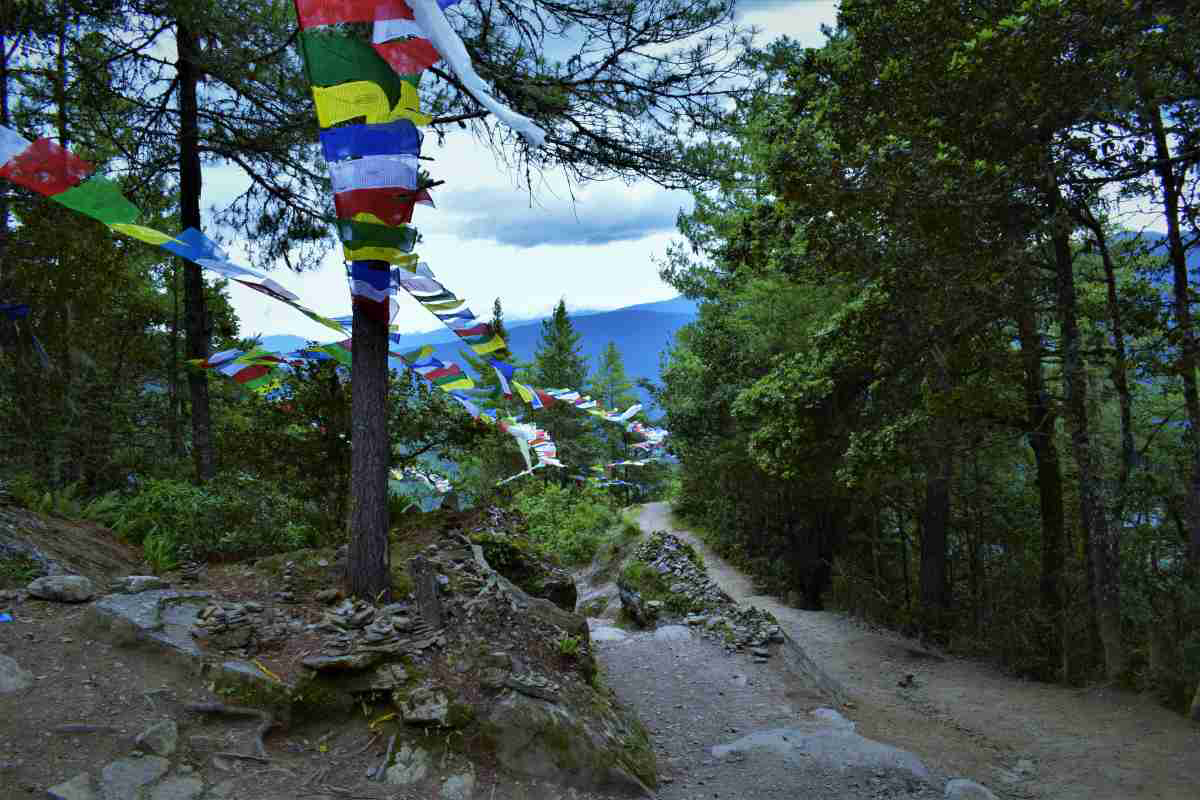
Taking a secret (to us) path back to the more familiar
Making good time, despite a bit of slipping and slithering, we reach the base. I will be honest with you and tell you that by this point, I am thinking of the lavender salts that await me in the hotel. More than anything else, though, I am overwhelmed. Something drew me all the way from India to this temple, when I haven’t even attempted a pilgrimage of this kind in my own country, one that abounds with places of worship.
Faith is inexplicable: evoking mixed reactions in most of the world, it forms the backbone of this kingdom. It draws the old and the young. It attracts mothers who bring their babies slung on their backs, elderly men who lean on their wives, to this distant temple in the clouds. There is no wrangling or bitterness on these paths, only silent prayers for contentment.
I turn back for a last look — there is Taktsang, nestled against the dark grey cliff, a tiny white speck, patiently taking in the seekers.
More from Culture
Comments
*Comments will be moderated




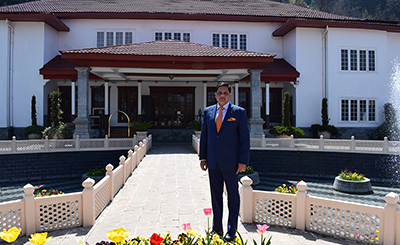


-thumbs.jpg)



